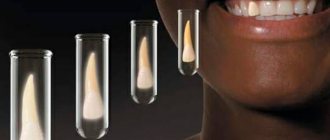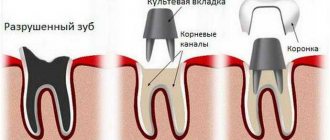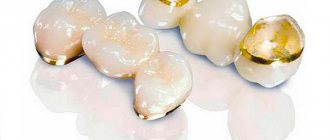Have you had to replace old fillings installed several years ago? Do you know what this threatens?
We will tell you how to avoid frequent replacement of fillings by using another dental restoration technology. In the article Filling, inlay or crown? We reviewed different methods of dental restoration, and today we will tell you in detail about the advantages of inlays .
An inlay is a filling made in a dental laboratory from filling materials, metals or ceramics.
Restoring a tooth with an inlay is more expensive than with a regular filling, and to understand whether it’s worth paying more , let’s figure out why an inlay is better than a filling. The benefits of inlays become obvious if you understand the reasons for replacing old fillings.
Let's start with the functions that the filling performs.
Material shrinkage is one of the reasons for replacing old fillings
Protection of the tooth from infection is ensured by the tightness of the connection at the border of the filling with the tooth tissue. Modern adhesive compounds reliably glue the filling to the tooth, but sometimes this can become a problem.
During curing, any material decreases in volume ( shrinks ) and filling material is no exception. By shrinking, the filling “pulls” on itself the parts of the tooth to which it is securely glued, and if the area of the filling is large, this force may be enough to cause cracks and chips to appear.
secondary caries forms at the site where the filling is torn from the tooth tissue .
Shrinkage of the filling material also poses other problems:
- with vertical shrinkage, the height of the bite changes, which leads to dysfunction of the temporomandibular joint and improper load on the filled tooth. As a result, the tooth may become damaged and require a crown to be installed to restore it.
- shrinkage of the filling horizontally leads to the disappearance of the contact point (point of contact) between adjacent teeth and stuck food puts pressure on the periodontal papilla, injuring it. The gums become inflamed, gingivitis, periodontitis and secondary caries develop.
Expert advice
The arrangement of teeth in a row was initially determined by nature, so the elements must touch correctly for the full implementation of the chewing function. A change in the bite can cause an incorrect distance between the jaws. Once such a pathology develops, it will be much more difficult for the doctor to eliminate it.
To minimize the likelihood of complications, the patient must take certain actions himself. If bite defects are observed within a few days after installing the composition, you should immediately consult a dentist. Correcting the filling will take a few minutes, but these manipulations will help prevent the development of disorders.
After installing the material, some people complain about roughness and stepped placement of the composition. Pathogenic microorganisms can accumulate in the formed cavities, which will lead to the development of secondary caries. In such cases, it is also necessary to urgently visit the dentist's office.
Category Dental filling Posted by Mister stomatolog
What are the consequences of insufficient filling strength?
The technology for making a filling (in the patient’s mouth) does not make it as strong as possible, so over time the filling material wears out.
As in the case of vertical shrinkage, abrasion of the filling can lead to problems:
- the level of bite changes , and this can lead to the chipping of part of the tooth due to the redistribution of the chewing load from the filling to the walls of the tooth.
- the boundary between the filling and the tooth tissue changes , while the filling loses its tightness and the infection penetrating inside provokes the development of secondary caries.
Home treatment methods
As mentioned above, it is impossible to get rid of the problem at home, and it is unreasonable to expect natural abrasion of the material.
To alleviate the condition before visiting a specialist, you need to follow certain recommendations:
- Avoid eating hard foods that require biting. The sealed unit, due to its higher location, is subject to the main load, and this is fraught with a fracture of its base.
- Eliminate hot foods from your diet. This is because such foods and drinks can cause swelling of the soft tissues, increasing the discomfort.
- For severe pain, analgesics or non-steroidal anti-inflammatory drugs can be used. However, you should not abuse such drugs, because their use is limited - no more than 5 days.
Other disadvantages of the filling and reasons for replacing it
- Inaccurate anatomical shape of the tooth.
Restoring the correct shape of a tooth in a patient’s mouth is a difficult task. This work requires the dental therapist to have a good knowledge of anatomy and the skill of a sculptor. But even with these skills, it is difficult to model the shape of a tooth in hard-to-reach places.Inaccurate tooth shape is the cause of malocclusion (especially if there are a lot of fillings). Teeth grind food incorrectly, causing discomfort when biting, headaches appear, teeth are injured in the process of chewing food and are destroyed over time.
- Overhanging edges of the filling.
If, when installing a filling, the material flows onto the gum and rests on it, this leads to permanent injury and inflammation of the gums.A filling installed with such a defect causes local periodontitis and secondary caries, since it is difficult to remove stuck food from the resulting “pocket.”
- Difficulty in thoroughly sanding surfaces .
In places of contact with neighboring teeth, it is impossible to completely get rid of the roughness of the filling, and dental plaque adheres well to such a surface. - Development of caries at the interface between tooth and filling . The gradual shrinkage of the filling material and the destruction of the adhesive connection makes the border between the tooth and the filling the most vulnerable place where secondary caries develops first.
- Changes in the color of the filling material and tooth tissue over time make the border of the filling too noticeable.
Symptoms of an incorrectly placed filling
Very often, patient complaints about discomfort after installing a filling have nothing to do with improper manipulation or excess materials. This often happens when most of the tooth has been destroyed and the patient has become accustomed to the emptiness. Consequently, after filling, a false feeling of discomfort appears, which is caused by an unusual feeling of fullness in a place that has been empty for a long time. In such situations, you need to wait a little - often within a few days a person gets used to the new sensations, and the installed filling ceases to cause discomfort.
First of all, you need to figure out how to understand whether the discomfort is associated with the adaptation period, or whether the unpleasant sensations are a consequence of the doctor’s incorrect actions.
There are several symptoms indicating improper installation of filling material:
- On the side of the tongue, in the place where the product is installed, pain is felt or there is a wound.
- During chewing, discomfort is replaced by a feeling of pressure or pain.
- After a visit to the doctor, the patient experiences articulation disorders - slurred pronunciation of sounds.
- When you try to compress your jaws, the presence of foreign material prevents you from doing so.
If at least one of the above-described signs appears, we can say that the structure requires additional polishing.
What does replacing a filling lead to?
What's wrong with changing the filling when needed? The problem is that you don’t know the exact time when the old filling stops performing its functions, but if part of the tooth breaks off, the doctor will be forced to put in a new, larger filling.
In the case of advanced caries and pulpitis, it may be necessary to remove the nerve, but a “dead” tooth is more fragile and fillings and inlays adhere less well to its tissues (which means the service life will be shorter).
We devoted the article Karis to the treatment of different stages of caries: what is it like? And why does treatment differ so much in price? Read it to understand how caries progresses.
With each filling replacement, the “native” tooth becomes smaller and the moment approaches when it can only be restored with a crown.
Causes
The main reason for the appearance of the symptoms described above is an excess of filling materials and inaccurate formation of the surface of the restored unit. Because of this, the surface of the tooth becomes slightly higher than necessary for proper closure of the jaws.
The qualifications of the specialist who performed the filling procedure are not always the cause of the problem. Often, local anesthesia is used during the installation of fillings, so the patient may not accurately describe his sensations when the specialist asks him to describe the sensations after the final polishing is completed. As a result, after the medication wears off, discomfort appears that was absent when you were in the dentist’s chair.
In some cases, the source of discomfort may be the inflammatory process of the periodontium, due to a violation of the stable position of the dental unit. Almost imperceptible tooth mobility can disable the mechanism of closure of the upper and lower jaw. But before the filling was carried out, the missing part of the unit compensated for the defect. Accordingly, after complete restoration of the size and shape of the tooth, the disease manifests itself in full.
Another cause of discomfort can be tooth misalignment. Often this symptom appears after filling a gap between teeth or removing a unit in the same row. Complaints that the filling is in the way appear several months after installation. The missing unit causes the remaining teeth to shift towards the empty space, so when they are closed tightly, unpleasant sensations appear.
A common cause can also be an excessively thin wall between the pulp chamber and the product. Because of this, the pressure that is applied to the filling during chewing is transferred to the bottom of the chamber and irritates the dental nerve. In such cases, the cause of the unpleasant sensations lies inside the dental unit, but is felt as a structural defect.
Why is a ceramic inlay better than a regular filling?
Unlike a filling, which a doctor makes in the mouth, an inlay goes through all stages of manufacturing in a dental laboratory. The dentist only processes the tooth cavity under the inlay and makes impressions of the jaws, and after making the inlay, glues it in place.
Restoring a tooth with an inlay requires two visits to the dentist, but ensures long-term functionality and aesthetic perfection of the restoration.
Advantages of ceramic inlays:
- Inlays do not shrink after placement because this process is completed during the manufacturing stage in the dental laboratory.
- Ceramic inlays have the highest strength and do not wear out over time, thanks to production technology. The inlay is pressed from a ceramic mass heated to high temperatures or machined from a single piece of ceramic.
- Inlays completely restore the anatomical shape of the tooth and chewing functions, thanks to the modeling of the bite in the articulator using casts of two jaws.
- Making an inlay with fitting on a plaster model makes it possible to create it without overhanging edges , restore tooth defects in hard-to-reach places, ensure correct interdental contact and good marginal fit of the inlay to the tooth. All this is difficult to do when making a filling in the oral cavity.
- All outer surfaces of the inlay (including those in contact with adjacent teeth) are perfectly ground before installation.
- It is easier to select the desired color and translucency of the inlay in the laboratory than in the patient’s mouth. Therefore, ceramic inlays are the best option for aesthetic dental restoration.
- The inlay is more reliably glued to the tooth, since the doctor requires a minimum of time to install an inlay of exactly the right size into the treated tooth cavity (due to the speed of installation, the risk of moisture and infection on the treated surfaces is reduced).
By restoring a tooth with a ceramic inlay, you get a high-quality, durable restoration and do not get tired during the appointment, since you do not need to sit for a long time with your mouth open.
For medical reasons, if the coronal part of the tooth is destroyed by more than 30%, it is recommended to install an inlay.
What to do when a filling falls out
Further treatment tactics depend on the patient’s behavior after the temporary filling falls out. If you do not take any action and wait for your appointment, then most likely the doctor will have to re-clean the tooth cavity or even carry out additional procedures to eliminate pathological processes that have arisen due to external factors. An open tooth is accessible to all infections and is highly undesirable at any stage of treatment.
If the filling falls out on the day of installation
In cases where the temporary filling falls out after 2 hours or approximately this time, you must immediately contact a specialist for re-filling.
What should you do if a temporary filling falls out in the evening, when you can no longer visit the dentist? In such a situation, it is necessary to close the cavity. For this, for example, you can purchase a special dentin paste or its analogues at the pharmacy. You should try to remove the remains of the filling, but without using sharp objects, so as not to damage the internal tissues and channels. After this, the cavity is filled with paste, and the next day they are sent to the attending physician.
If it is not possible to purchase such a paste, it is recommended to minimize food intake and constantly rinse your mouth with mouthwash or other antiseptic agents. Rinsing is necessary after each meal to flush out food particles from the exposed tooth that may get into the cavity.
Loss of filling in sealed and unsealed canals
The greatest risk occurs when a temporary filling falls out and the canals are not sealed. Due to the high probability of contamination of the dental canals, the patient should also “seal” the tooth with paste, or rinse the tooth regularly. You can also use a soda solution for rinsing. On the same day or the next day, the patient must go to the clinic to take measures to close the cavity in the crown.
If a temporary filling falls out, but the canals are sealed, what should I do? In such patients, the likelihood of complications is minimal, since neither infection nor foreign particles can penetrate into the canals themselves. But it is still impossible to leave the cavity open, since the crown is weakened and its internal tissues are not protected from mechanical stress. Patients are also advised to rinse as a preventative measure and to see a dentist again, who may even install a permanent filling right away.
Types of ceramic inlays
- inlay tab - restores the “cavities” of the tooth crown
- onlay tab - restores most of the chewing surface of the tooth crown
- overlay tab - restores the chewing surface and side walls of the tooth crown
The service life of the inlays is more than 10 years, while the filling will require replacement after an average of 5 years.
Now, when a dentist suggests restoring a tooth with an inlay, you know what benefits this will provide in the future.
Lost temporary filling
Temporary fillings are placed for the purpose of medical treatment of the tooth. In this way, the filling material seals the medicine in the dental cavity. If a temporary filling fails prematurely, the drug can get on other tissues in the oral cavity, which is not always harmless. Therefore, a tooth with a temporary filling should be protected and not burdened with chewing. If the medicine remains after such a filling falls out, you need to carefully remove it with a cotton swab. And then contact the dentist as soon as possible.
How to extend the service life of filling material
How often the filling will have to be changed depends on how correctly it is used. To extend the life of the material, just listen to the following tips:
- don’t skimp on material: very cheap means it won’t last long,
- avoid increased stress on the filling: do not open bottles, avoid excessively hard foods,
- avoid sudden changes in temperature in the oral cavity: do not take too hot or cold food,
- select oral hygiene items and products in accordance with the characteristics of the teeth.
In addition, even in the absence of complaints, you need to regularly visit the dentist for timely detection of pathologies and defects. It is better to spend a few minutes grinding than to have to refill it after some time. Preventative visits will save time and money, and will also keep your nerves and teeth in perfect order.
How long can a filling last?
The service life of a filling is determined by several factors, the main ones being the following:
- correct installation and size,
- characteristics of the material from which it is made,
- the condition of the abutment tooth, the thickness of its walls,
- features of hygienic care: brush hardness, abrasiveness of pastes, etc.
- the presence or absence of certain habits: for example, high consumption of nuts, seeds, opening corks with teeth,
- the predominance of solid and/or tough foods in the diet, and so on.
As a rule, the minimum service life is 3-5 years, but some materials can last 10 years or more. In fact, it depends more on the condition of the treated tooth itself after a while.









